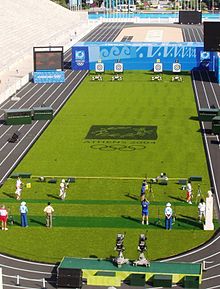|
|
 |
|
|
|
|
|
|
|
|
|
|
|
|
|
|
|
|
|

World greatest & first athletics stadium is Alsatan by Stockmeier Urethanes
The track was built by Stockmeier's Greece agent, Athletika Sports Greece, and is Alsatan SW.
.jpg)
In ancient times it was used to host the athletic portion of the Panathenaic Games in honour of the Goddess Athena. During classical times the stadium had wooden seating. It was remade in marble by the archon Lycurgus in 329 BC and was enlarged and renovated by Herodes Atticus in 140 AD, to a seated capacity of 50,000. The remnants of the ancient structure were excavated and refurbished, with funds provided by Evangelis Zappas for the revival of the Olympic Games.[2] Evangelis Zappas sponsored the "Zappas Olympics", that were held there in 1870 and 1875.[2] The stadium was refurbished a second time in 1895 for the 1896 Olympics, with completion funding provided by the Greek benefactor George Averoff (whose marble statue now stands at the entrance), based on designs by architects Anastasios Metaxas and Ernst Ziller. The stadium was built long before dimensions for athletics venues were standardized and its track and layout follow the ancient hairpin-like model. It could seat about 80,000 spectators on 50 rows of marble steps and currently holds 45,000 spectators.[1]
It is located in downtown Athens, east of the National Gardens and the Zappeion Exhibition Hall, west of the Pankrati residential district and between the twin pine-covered hills of Ardettos and Agra. Up to the 1950s, the Ilissos River (now covered by, and flowing underneath, Vasileos Konstantinou Avenue) ran in front of the stadium's entrance, and the spring of Kallirrhoe, the sanctuary of Pankrates (a local hero) and the Cynosarges public gymnasium were nearby.
The Fokianos sports facility lies across Vasileos Konstantinou Avenue, and adjacent to it are located the Athens tennis club, the Ethnikos athletics track, the Federation swimming pool, the remnants of the Temple of Olympian Zeus, and Hadrian's Gate. Until the late 19th century and the containment of the Ilissos riverbed, the area was reedy and often flooded, and was called the "Vatrahonisi" (Frog Island).
In more recent years this stadium has been often used to honour the homecoming of victorious Greek athletes, most notably the Greek national football team after its victory at the 2004 European Football Championship and also the opening ceremony of the World Athletics Championships in 1997, on a concept by composer Vangelis Papathanasiou.
In the 2004 Olympic Games, the Panathinaiko Stadium hosted the archery competition, and the finish of the Marathon.











